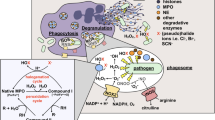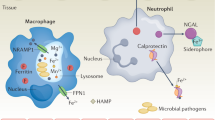Abstract
This review focusses on two questions: (1) How can the intracellular toxicity of ions such as Ca2+ or Zn2+ be reconciled with their extracellular benefit? (2) Why is the dietary requirement for Zn2+ so high when its documented biological role is that of a tightly-bound prosthetic group of certain enzymes? An answer to both questions is provided by the observation that extracellular cations such as Ca2+ and Zn2+ protect the plasma membrane of cells against non-specific leakage, including an influx of Ca2+ or Zn2+. It is suggested that such protection, against leakage induced by microbial and other toxins, may contribute to the high dietary requirement for zinc. These arguments lead to the proposal that a previously unrecognized form of host defence is one of protection of the cell plasma membrane by divalent cations against damage induced by cytotoxic agents of environmental origin.
Similar content being viewed by others
References
Avigad, L. S. and Bernheimer, A. W. (1976). Inhibition by zinc of hemolysis induced by bacterial and other cytolytic agents.Infect. Immunol. 13:1378–1381.
Avruch, J. and Wallach, D. F. H. (1971). Preparation and properties of plasma membrane and endoplasmic reticulum fragments from isolated rat fat cells.Biochim. Biophys. Acta 233:334–347.
Bashford, C. L. and Pasternak, C. A. (1984). Plasma membrane potential of Lettre cells does not depend on cation gradients but on pumps.J. Membrane Biol. 79:275–284.
Bashford, C. L. and Pasternak, C. A. (1986). Plasma membrane potential of some animal cells is generated by ion pumping, not by ion gradients.Trends in Biochem. Sci. 11:113–116.
Bashford, C. L., Alder, G. M., Patel, K. and Pasternak, C. A. (1984). Common action of certain viruses, toxins, and activated complement: pore formation and its prevention by extracellular Ca2+.Biosci. Rep. 4:797–805.
Bashford, C. L., Alder, G. M., Menestrina, G., Micklem, K. J., Murphy, J. J. and Pasternak, C. A. (1986). Membrane damage by haemolytic viruses, toxins, complement and other cytotoxic agents: a common mechanism blocked by divalent cations.J. Biol. Chem. 261:9300–9308.
Bettger, W. J. and O'Dell, B. L. (1981). A critical physiological role of zinc in the structure and function of biomembranes.Life Sci. 28:1425–1438.
Bough, R. F. and Hougie, C. (1977). Biochemistry of blood coagulation. In:Recent Advances in Blood Coagulation (L. Poller, Ed.), Churchill Livingstone, pp. 1–34.
Boyle, M. D., Langone, J. J. and Borsos, T. (1979). Studies on the terminal stages of immune hemolysis. IV. Effects of metal salts.J. Immunol. 122:1209–1213.
Campbell, A. K. and Morgan, B. P. (1985). Monoclonal antibodies demonstrate protection of polymorphonuclear leukocytes against complement attack.Nature 317:164–166.
Chvapil, M. (1976). Effect of zinc on cells and biomembranes.Medical Clinics of North America 60:799–812.
Cobbold, P. H. and Bourne, P. K. (1984). Aequorin measurements of free calcium in single heart cells.Nature 312:444–446.
DiPolo, R. and Beaugé, L. (1983). The calcium pump and sodium-calcium exchange in squid axons.Ann. Rev. Physiol. 45:313–324.
Eby, G. A., Davis, D. R. and Halcomb, W. W. (1984). Reduction in duration of common colds by zinc gluconate lozanges in a double-blind study.Antimicrobial Agents and Chemother. 25:20–24.
Editorial (1981). Another look at zinc.Brit. Med. J. 288:1098–1099.
Frankenhauser, B. and Hodgkin, A. L. (1957). The action of calcium on the electrical properties of squid axons.J. Physiol. 137:218–244.
Freer, J. H. and Arbuthnott, J. P. (1976). Biochemical and morphologic alterations of membranes by bacterial toxins. In:Mechanisms in Bacterial Toxicology (A. W. Bernheimer, Ed.), Wiley, NY, pp. 169–194.
French, R. J., Krueger, B. K. and Worley, J. F. (1986). From brain to bilayer: sodium channels from rat neurons incorporated into planar lipid membranes. In:Ionic Channels in Cells and Model Systems (R. Latorre, Ed.), Plenum Press, NY, pp. 273–290.
Götze, O., Haupt, I. and Fischer, H. (1968). Immune haemolysis reaction of the terminal complement component.Nature 217:1165–1167.
Habermann, E. (1979). Bee and wasp venoms. The biochemistry and pharmacology of their peptides and enzymes are reviewed.Science 177:314–322.
Hambridge, K. M. and Aggett, P. J. (1984). Zinc in human medicine: proceedings of a symposium on the role of zinc in health and disease. TIL Publications Ltd, Isleworth and Toronto.
Hoffman, J. F. and Forbush, B. (eds.) (1983).Structure, Mechanism and Function of the Na/K Pump. Academic Press, NY.
Högberg, B. and Uvnäs, B. (1960). Further observations on the disruption of rat mesentery mast cells caused by compound 48/80, antigen/antibody reaction, lecithinase A and decylamine.Acta Physiol. Scand. 48:133–145.
Impraim, C. C., Micklem, K. J. and Pasternak, C. A. (1979). Calcium, cells and virus: alterations caused by paramyxoviruses.Biochem. Pharmacol. 28:1963–1969.
Isomaa, B., Hägerstrand, H., Paatero, G. and Engblom, A. C. (1986). Permeability alterations and antihaemolysis induced by amphiphiles in human erythrocytes.Biochim. Biophys. Acta 860:510–524.
Kazimierczak, W. and Maslinski, C. (1974). The effect of the zinc ions on selective and non-selective histamine releasein vitro.Agents and Actions 4:1–6.
Lemasters, J. J., DiGiuseppi, J., Nieminen, A.-L. and Herman, B. (1987). Blebbing, free Ca2+ and mitochondrial membrane potential preceding cell death in hepatocytes.Nature 325:78–81.
Liljas, A. and Rossmann, M. G. (1974). X-ray studies of protein interactions.Ann. Rev. Biochem. 43: 475–507.
Maher, P. and Singer, S. J. (1984). Structural changes in membranes produced by the binding of small amphipathic molecules.Biochemistry 23:232–240.
Mayer, M. M. (1972). Mechanism of cytolysis by complement.Proc. Nat. Acad. Sci. USA 69:2954–2958.
Menestrina, G. (1986). Ionic channels formed by Staphylococcus aureus alpha toxin: voltage-dependent inhibition by divalent and trivalent cations.J. Membr. Biol. 90:177–190.
Metcalfe, J. C., Pozzan, T., Smith, G. A. and Hesketh, T. R. (1980). A calcium hypothesis for the control of cell growth.Biochem. Soc. Symp. 45:1–26.
Metzler, D. E. (1977).Biochemistry: The Chemical Reactions of Living Cells. Academic Press, NY, pp. 397.
Micklem, K. J., Nyaruwe, A. and Pasternak, C. A. (1985). Permeability changes resulting from virus-cell fusion: temperature-dependence of the contributing process.Molecular and Cellular Biochem. 66:163–173.
Mims, C. A. (1983). Immunopathology in virus disease.Phil. Trans. R. Soc. B. 303:189–198.
Morgan, B. P. and Campbell, A. K. (1985). The recovery of human polymorphonuclear leucocytes from sublytic complement attack is mediated by changes in intracellular free calcium.Biochem. J. 231:205–208.
Morgan, B. P., Dankert, J. R. and Esser, A. F. (1987). Recovery of human neutrophils from complement attack: removal of the membrane attack complex by endocytosis and exocytosis.J. Immunol. 138:246–253.
Pasternak, C. A. (1987a). Virus, toxin, complement: common actions and their prevention by Ca2+ or Zn2+.BioEssays 6:14–18.
Pasternak, C. A. (1987b). Role of calcium in membrane changes triggered by viruses, toxins and other agents. In:The Role of Calcium in Biological Systems, Vol. 3 (L. J. Anghileri, Ed.), CRC Press Inc., Boca Raton, in press.
Pasternak, C. A., Bashford, C. L. and Micklem, K. J. (1985a). Ca2+ and the interaction of pore-formers with membranes.Proc. Int. Symp. Struct. Interactions, Suppl. J. Biosci. 8:273–291.
Pasternak, C. A., Alder, G. M., Bashford, C. L., Buckley, C. L., Micklem, K. J. and Patel, K. (1985b). Cell damage by viruses, toxins and complement: common features of pore-formation and its inhibition by Ca2+. In:The Molecular Basis of Movement Through Membranes (C. A. Pasternak and P. J. Quinn, Eds.),Biochem. Soc. Symp. 50:247–264.
Poste, G. and Pasternak, C. A. (1978). Mechanisms of virus-induced cell fusion. In:Cell Surface Reviews 5 (G. Poste and G. L. Nicolson, Eds.), North Holland Publishing Co., Amsterdam, New York and Oxford, pp. 306–349.
Prasad, A. S. (1978).Trace Elements and Iron in Human Metabolism. John Wiley & Sons, Chichester, pp. 251–346.
Rickauer, M. and Tanner, W. (1986). Effects of Ca2+ on amino acid transport and accumulation in roots ofPhaseolus vulgaris, Plant. Physiol. 82:41–46.
Schanne, F. A. X., Kane, A. B., Young, E. E. and Farber, J. L. (1979). Calcium dependence of toxic cell death: a final common pathway.Science 206:700–702.
Seeman, P. H. (1972). The membrane actions of anaesthetics and tranquilisers.Pharmacol. Rev. 24:583–655.
Snyder, S. L. and Walker, R. I. (1976). Inhibition of lethality in endotoxin-challenged mice treated with zinc chloride.Infect. Immunol. 13:998–1000.
Taylor, R. E., Armstrong, C. M. and Bezanilla, F. (1976). Block of sodium channels by external calcium ions.Biophys. J. 16:27a.
Tocco-Bradley, R. and Kluger, M. (1984). Zinc concentration and survival in rats infected withSalmonella typhimurium.Infect. Immunol. 45:332–338.
True, R. H. (1914). The harmful action of distilled water.Ann. J. Bot. 1:255–273.
Trump, B. F. and Berezesky, I. K. (1985). Cellular ion regulation and disease: a hypothesis. In:Regulation of Calcium Transport Across Muscle Membranes (F. Bronner and A. E. Shamoo, Eds.), Academic Press, NY, pp. 279–319.
Trump, B. F., Berezesky, I. K. and Osornio-Vargas, A. R. (1981). Cell death and the disease process. The role of calcium: In.Cell Death in Biology and Pathology (I. D. Bowen and R. A. Lockshin, Eds.), pp. 209–242. Chapman and Hall, London.
Vallee, B. L. and Walker, W. E. C. (1970). Metalloproteins. In:The Proteins: Composition, Structure and Function (H. Neurath, Ed.), 2nd edn, Vol. 5, Academic Press, NY, pp. 1–192.
Wada, L., Turnlund, J. R. and King, J. C. (1985). Zinc utilization in young men fed adequate and low zinc intakes.J. Nutr. 115:1345–1354.
Williams, R. J. P. (1984). Zinc: what is its role in biology?Endeavour 8:65–70.
Williams, R. J. P. (1985). The symbiosis of metal and protein functions.Eur. J. Biochem. 150:231–248.
Woodhull, A. M. (1973). Ionic block of sodium channels in nerve.J. Gen. Physiol. 61:687–708.
Wyn Jones, R. G. and Lunt, O. R. (1967). The function of calcium in plants.Bot. Rev. 33:407–426.
Yamamoto, K. and Takahashi, M. (1975). Inhibition of the terminal stage of complement-mediated lysis (reactive lysis) by zinc and copper ions.Int. Arch. Allergy Appl. Immunol. 48:653–663.
Yamamoto, D., Yeh, J. Z. and Narahashi, T. (1984). Voltage-dependent calcium block of normal and tetramethrin-modified sodium channels.Biophys. J. 45:337–344.
Zubay, G. (1983).Biochemistry. Addison-Wesley, Reading, Mass., pp. 236–237.
Author information
Authors and Affiliations
Rights and permissions
About this article
Cite this article
Pasternak, C.A. A novel form of host defence: Membrane protection by Ca2+ and Zn2+ . Biosci Rep 7, 81–91 (1987). https://doi.org/10.1007/BF01121871
Received:
Issue Date:
DOI: https://doi.org/10.1007/BF01121871




